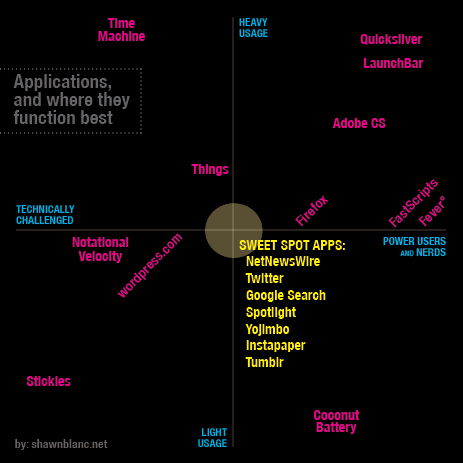I have always been the most enthusastic of applications that sit in the Software Sweet Spot.
Photoshop, for example, is not such an app. It has a steep learning curve, and if you don’t use it for for the heavy-lifting design for which it was built it feels bulky. Hence Neven Mrgan’s gripe: “My problem with Photoshop is that it was designed for 300 dpi work, but I mostly use it for 72.009 dpi images.”
In my mind I imagine the scalability of an app as being two dimensional — stretching both horizontal and vertical. “Horizontal Scalability” means the app is useful and helpful for basic users and power users alike. It doesn’t matter if you’re a total noob or a total nerd, the app works great for you.
“Vertically Scalability” could mean two things: First, that regardless of if you utilize one feature or all of them the app sustains its ease and joy of use. Meaning, you aren’t missing out if you only use a few features, nor are you held back if you use many. Secondly, it could mean if you use the app all day every day, or only once in a while, you still get a bang for your buck.
Here is a chart with many apps I use, and where I think they land in terms of scalability. Admittedly, it is somewhat flawed from the start, but I still think it accurately communicates the point.
There is no good or bad area on this chart — the top right is no better than the bottom left. I am extremely fond of nearly every app on this chart. However, the apps I most frequently recommend are the ones that sit in the Sweet Spot. These apps are great regardless of who uses them and how often they get used.
An interesting side note: the majority of apps seemed to fall into the top right and bottom left areas. Also, it was surprisingly difficult to find an app for the bottom right spot. Coconut Battery was the only app I could think of that is geared for power users and nerds yet isn’t necessarily something you would use on a regular basis.
